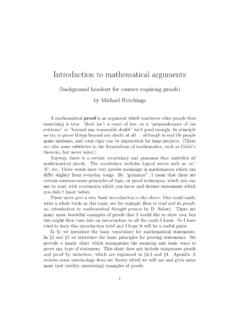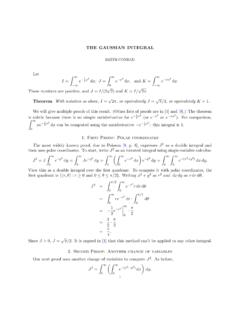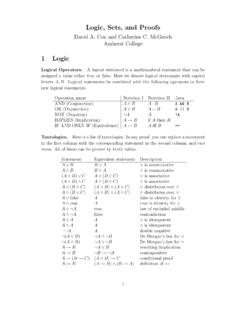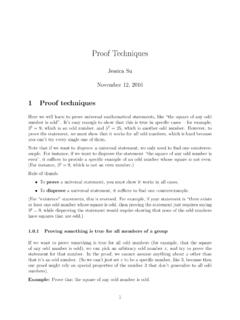Transcription of Direct Proofs - Stanford University
1 Direct Proofs Recommended ReadingA Brief History of InfinityThe Mystery of the AlephEverything and More Recommended CoursesMath 161: Set Theory What is a proof ? Induction and Deduction In the sciences, much reasoning is done inductively. Conduct a series of experiments and find a rule that explains all the results. Conclude that there is a general principle explaining the results. Even if all data are correct, the conclusion might be incorrect. In mathematics, reasoning is done deductively. Begin with a series of statements assumed to be true. Apply logical reasoning to show that some conclusion necessarily follows. If all the starting assumptions are correct, the conclusion necessarily must be correct.
2 Structure of a Mathematical proof Begin with a set of initial assumptions. Some will be explicitly stated, others assumed as background knowledge. Apply logical reasoning to derive the final result from those initial assumptions. Assuming all intermediary steps follow sound logical reasoning, the final result necessarily follows from the assumptions. It is a secondary question whether the initial assumptions are correct; that's the domain of the philosophy of mathematics. Direct Proofs Direct Proofs A Direct proof is the simplest type of proof . Starting with an initial set of assumptions, apply simple logical steps to derive the result.
3 Directly prove that the result is true. Contrasts with indirect Proofs , which we'll see on Friday. Two Quick Definitions An integer n is even if there is some integer k such that n = 2k. This means that 0 is even. An integer n is odd if there is some integer k such that n = 2k + 1. We'll assume the following for now: Every integer is either even or odd. No integer is both even and odd. A Simple Direct ProofTheorem: If n is an even integer, then n2 is :Let n be an even integer. Since n is even, there is some integer ksuch that n = 2k. This means that n2 = (2k)2 = 4k2 = 2(2k2). Since 2k2 is an integer, this means thatthere is some integer m (namely, 2k2) suchthat n2 = 2m.
4 Thus n2 is even. This symbol means end of proof This symbol means end of proof A Simple Direct ProofTheorem: If n is an even integer, then n2 is :Let n be an even integer. Since n is even, there is some integer ksuch that n = 2k. This means that n2 = (2k)2 = 4k2 = 2(2k2). Since 2k2 is an integer, this means thatthere is some integer m (namely, 2k2) suchthat n2 = 2m. Thus n2 is even. To prove a statement of the form If P, then Q Assume that P is true, then show that Q must be true as prove a statement of the form If P, then Q Assume that P is true, then show that Q must be true as well. A Simple Direct ProofTheorem: If n is an even integer, then n2 is :Let n be an even integer.
5 Since n is even, there is some integer ksuch that n = 2k. This means that n2 = (2k)2 = 4k2 = 2(2k2). Since 2k2 is an integer, this means thatthere is some integer m (namely, 2k2) suchthat n2 = 2m. Thus n2 is even. This is the definition of an even integer. When writing a mathematical proof , it's common to call back to the is the definition of an even integer. When writing a mathematical proof , it's common to call back to the definitions. A Simple Direct ProofTheorem: If n is an even integer, then n2 is :Let n be an even integer. Since n is even, there is some integer ksuch that n = 2k. This means that n2 = (2k)2 = 4k2 = 2(2k2).
6 Since 2k2 is an integer, this means thatthere is some integer m (namely, 2k2) suchthat n2 = 2m. Thus n2 is even. Notice how we use the value of k that we obtained above. Giving names to quantities, even if we aren't fully sure what they are, allows us to manipulate them. This is similar to variables in how we use the value of k that we obtained above. Giving names to quantities, even if we aren't fully sure what they are, allows us to manipulate them. This is similar to variables in programs. A Simple Direct ProofTheorem: If n is an even integer, then n2 is :Let n be an even integer. Since n is even, there is some integer ksuch that n = 2k.
7 This means that n2 = (2k)2 = 4k2 = 2(2k2). Since 2k2 is an integer, this means thatthere is some integer m (namely, 2k2) suchthat n2 = 2m. Thus n2 is even. Our ultimate goal is to prove that n2 is even. This means that we need to find some m such thatn2 = 2m. Here, we're explicitly showing how we can do ultimate goal is to prove that n2 is even. This means that we need to find some m such thatn2 = 2m. Here, we're explicitly showing how we can do that. A Simple Direct ProofTheorem: If n is an even integer, then n2 is :Let n be an even integer. Since n is even, there is some integer ksuch that n = 2k. This means that n2 = (2k)2 = 4k2 = 2(2k2).
8 Since 2k2 is an integer, this means thatthere is some integer m (namely, 2k2) suchthat n2 = 2m. Thus n2 is even. Hey, that's what we were trying to show! We're done , that's what we were trying to show! We're done now. An Important Result Set equality is defined as followsA = B precisely when every elementof A belongs to B and vice-versa This definition makes it a bit tricky to prove that two sets are equal. It's often easier to use the following result to show that two sets are equal:For any sets A and B,if A B and B A, then A = B. Theorem:For any sets A and B, if A B and B A, then A = : Let A and B be arbitrary sets such that A B andB definition, A B means that for all x A,x definition, B A means that for all x B,x whenever x A, x B and whenever x B,x A as , A = B.
9 How do we prove that this is true for any choice of sets?How do we prove that this is true for any choice of sets? Proving Something Always Holds Many statements have the formFor any X, P(X) is true. Examples:For all integers n, if n is even, n2 is even. For any sets A and B, if A B and B A, then A = B. For all sets S, |S| < | (S)|. Everybody's looking forward to the weekend, weekend. How do we prove these statements when there are (potentially) infinitely many cases to check? Arbitrary Choices To prove that P(x) is true for all possible x, show that no matter what choice of x you make, P(x) must be true. Start the proof by making an arbitrary choice of x: Let x be chosen arbitrarily.
10 Let x be an arbitrary even integer. Let x be an arbitrary set containing 137. Consider any x. Demonstrate that P(x) holds true for this choice of x. Theorem:For any sets A and B, if A B and B A, then A = B. proof : Let A and B be arbitrary sets such that A B andB A. By definition, A B means that for all x A,x B. By definition, B A means that for all x B,x A. Thus whenever x A, x B and whenever x B,x A as well. Consequently, A = B. We're showing here that regardless of what A and B you pick, the result will still be 're showing here that regardless of what A and B you pick, the result will still be true.


















